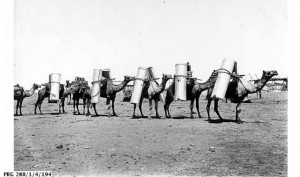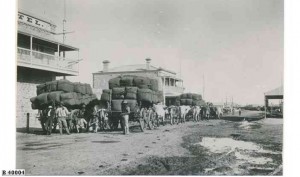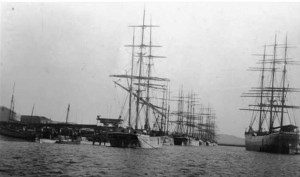Port Augusta
(See Wadlata http://www.wadlata.sa.gov.au/)
Port Augusta’s position at the head of Spencer Gulf makes it an important centre for trade and communications. Traffic crosses the continent here, from north to south and east to west.
Beginnings
• Alexander Elder, brother of Thomas Elder, sailed up the Spencer Gulf in 1852, looking for a landing place where they could build a wool store and form a town. He found it at Port Augusta.
• Elder was ‘a canny Scottish businessman’ who probably hoped that naming the port after Lady Augusta Young, wife of the Governor, would speed up the survey of the township and so help his company, Elder and Company, in exporting wool from their holdings in the north.
• Two years later (1854) , the port town of Port August was laid out by the government surveyor, another (unrelated) Elder. Early Trade and Communications Hub – Wool, copper ore and grain went out to market from here, and supplies for the northern settlers were brought in.
Goods were carried by bullocks, donkeys and camels to and from the port to the inland – across the Flinders Ranges through Horrocks Pass to Wilmington and Pichi Richi Pass to Quorn, Willochra and beyond.

State Library of South Australia PRG 280/1/4/194. The first large shipments of camels came in through Port Augusta in the 1860s. This team is heading inland from Port Augusta with heavy loads of metal sheeting, about 1907,
The cycles of boom and bust affected the port town as well as the country inland: o During the great drought of the 1860s, the fall in exports and imports meant there was high unemployment and great hardship in Port Augusta.
- The agricultural expansion of the 1870s was a great time for Port Augusta businesses, which quickly established connections with the newly opened areas, providing much work for teamsters.

State Library of South Australia B40004 Bullock team carrying wool to port. Port Augusta about 1889.
As the settlement grew, the environment deteriorated rapidly. Trees were felled for firewood and goats ate shrubs and grass. Soon the sandy soil was drifting into the gulf, filling in the harbour channel.
Wheat and wool went out by mostly small ships.

State Library of South Australia B68911.
Three-masted sailing ships waiting to load wheat, 1920.

State Library of South Australia PRG 280/1/2/458. Grain vessels loading at the Port Augusta Wharf 1904.
- In the 1860s and 1870s, Port Augusta took its place in the emerging national communication systems
- The new telegraph line connected Port Augusta to Melrose and Adelaide in 1866, and ran all the way through Central Australia to Darwin by 1872.
- The Royal Flying Doctor Service and the School of the Air both have bases there.
Railway Connections for the North
In the late 1870s, the Great Northern Railway was started after years of lobbying from pastoralists and miners. Agricultural land had opened up as far as Quorn by then, and seemed likely to go much further.
Port Augusta became the great northern railway launch pad for South Australia.
A link went from Port Augusta through the Pichi Richi Pass to Quorn from which farm produce was expected to make its way to market. North from Port Augusta the line was surveyed as far as Government Gums (later Farina). – Port Augusta was also the starting point for the SA end of the great railway that was eventually to connect Western Australia to the Eastern states. o Work began in 1912 after years of planning.
- The Commonwealth Railway workshops were built on what was then the edge of the town.
- The two ends of the line met in the desert in 1917.
Continuing Change
Port Augusta’s position as a regional centre meant it had a full rang of social organisations and the buildings to house them – churches, schools, Masonic lodge, Institute, a race course and so on.
It is a regional administration centre for many government services that reach into the interior.
The town had a major boost when it got a permanent water supply in 1944 from the Morgan-Whyalla pipeline.
The great regional power station was built in the 1950s to generate electricity from Leigh Creek coal. Its future is now under discussion as the Leigh Creek coalfields face a limited future (See Mining: Coal).
Online Resource
The Wadlata Outback Centre http://www.wadlata.sa.gov.au/ is a great introduction to Port Augusta, the Flinders Ranges and the Outback. A two hour heritage walk of the town starts from the centre.
Resources
- Barker, S, M M McCaskill and B Ward, eds. c.2005 Explore the Flinders Ranges. Royal Geographical Society of Australasia (S.A Branch).
- Manning, G.H. 2006. Manning’s Place Names of South Australia …an Extension and Revision… Gould Books, Modbury South Australia.
- Mincham, Hans 1983. The Story of the Flinders Ranges. (3rd ed). Adelaide, Rigby.
- Nicol, Stuart 1998 Flinders Ranges and the Mid North . Adelaide. Royal Automobile Association of South Australia.
- Gosse, Fayette, ‘Elder, Alexander Lang (1815–1885)’, Australian Dictionary of Biography, National Centre of Biography, Australian National University, http://adb.anu.edu.au/biography/elder-alexander-lang-3888/text5319, accessed 14 June 2012
